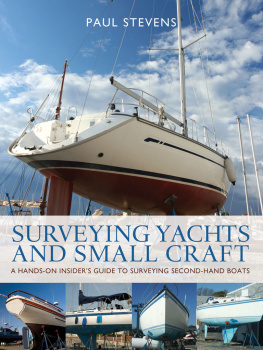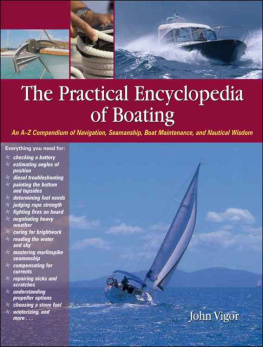

This electronic edition published in 2015 by Bloomsbury Publishing Plc
Adlard Coles Nautical
An imprint of Bloomsbury Publishing Plc
| 50 Bedford Square | 1385 Broadway |
| London | New York |
| WC1B 3DP | NY 10018 |
| UK | USA |
www.bloomsbury.com
BLOOMSBURY and the Diana logo are trademarks of Bloomsbury Publishing Plc
ADLARD COLES, ADLARD COLES NAUTICAL and the Buoy logo are trademarks of Bloomsbury Publishing Plc
First published 2015
Adlard Coles Nautical, 2015
Andy Johnson has asserted his right under the Copyright, Designs and Patents Act, 1988, to be identified as Author of this work.
All rights reserved
You may not copy, distribute, transmit, reproduce or otherwise make available this publication (or any part of it) in any form, or by any means (including without limitation electronic, digital, optical, mechanical, photocopying, printing, recording or otherwise), without the prior written permission of the publisher. Any person who does any unauthorised act in relation to this publication may be liable to criminal prosecution and civil claims for damages.
No responsibility for loss caused to any individual or organization acting on or refraining from action as a result of the material in this publication can be accepted by Bloomsbury or the author.
British Library Cataloguing-in-Publication Data A catalogue record for this book is available from the British Library. Library of Congress Cataloguing-in-Publication data has been applied for.
ISBN: HB: 978-1-4081-8779-1
ePDF: 978-1-4729-2205-2
ePub: 978-1-4729-2204-5
Typeset in Antenna, Veljovic Book and Bliss Colour origination by Ivy Press Reprographics Printed and bound in China by C&C Offset Printing Co
Produced for Adlard Coles Nautical by Ivy Contract
MANAGING EDITOR: Judith Chamberlain-Webber
COMMISSIONING EDITOR: Sarah Doughty
PROJECT DESIGNER: Kevin Knight
CONSULTANT: Andrew Simpson
Note: while all reasonable care has been taken in the publication of this book, the publisher takes no responsibility for the use of the methods or products described in the book.
Bloomsbury Publishing Plc makes every effort to ensure that the papers used in the manufacture of our books are natural, recyclable products made from wood grown in well-managed forests. Our manufacturing processes conform to the environmental regulations of the country of origin.
To find out more about our authors and books visit www.bloomsbury.com. Here you will find extracts, author interviews, details of forthcoming events and the option to sign up for our newsletters.
Contents

Welcome to boat electrics
If you have never attempted electrical work on a boat, or are reluctant to try, this book takes the mystery out of the wires, switches, fuses and other parts associated with a boats battery powered, low voltage electrical equipment. Where necessary, the detailed explanations will enable you to gain a good insight into how it all works.
Many boatowners may feel unsure about tackling any electrical problems on their boat. However, with some basic knowledge and understanding, most aspects of the battery based, low voltage electrics that you are likely to find on your boat can be tackled.
It is not necessary to have a lot of complicated tools and equipment a few basic items including a multimeter should be enough. The main focuses are to understand what is necessary to install a new piece of equipment and how to find and rectify problems or faults in existing systems.
Safety is always paramount and all aspects of working on boats have potential dangers. The low voltage battery based (12 volt and 24 volt) electrical systems are inherently safe but care is necessary because the batteries store a substantial amount of energy. Although mains electricity on board is discussed, working on high voltage systems is not covered in as much detail.

The distribution panel can take any format but is essentially a collection of switches and indicators controlling the power distribution to the boats electrical equipment. It often also includes the fusing arrangements.
Key concepts
The concepts of voltage, current, resistance and power are all fundamental to the functioning of electrical systems. This is because:
 Without sufficient voltage, the equipment may not operate correctly.
Without sufficient voltage, the equipment may not operate correctly.
 The correct wire size and most appropriate fusing arrangements, to protect the wiring, can be established based on the operating current consumed by the equipment.
The correct wire size and most appropriate fusing arrangements, to protect the wiring, can be established based on the operating current consumed by the equipment.
 The operating current can be derived either by measurement or from the power consumption printed on the equipment itself or in its operating manual.
The operating current can be derived either by measurement or from the power consumption printed on the equipment itself or in its operating manual.
Since the whole low voltage system depends on the batteries, a thorough understanding of the different types available, how many you might need and how they work is important. Although they are low maintenance items, the way in which they are used and recharged will influence their performance and lifespan.
From the batteries, individual circuits feed electrical power to the many pieces of equipment on the vessel. Between the batteries and the equipment is an arrangement of switches, fuses, distribution panels, indicator lights and, of course, a mass of wire. There may be only one means of recharging the batteries on board your engine (or at least the alternator attached to the engine) or a whole raft of sources including shore power, solar power, wind power and water power. The management and regulation of these is worth knowing about as it will improve your boats functioning.

The multimeter is arguably the most useful tool. It measures voltage and current as well as resistance and continuity. Without one you are very limited in the electrical work and fault finding you can do.

The batteries are the heart of the electrical system on boats. They store the energy, making it available when required.
Electronics and instrument systems
Nowadays, communication between instruments, radar, AIS and other aids to navigation and systems monitoring is a fundamental part of operating a boat. To understand how to get the best out of the various networks available, particularly NMEA0183 and NMEA2000 (or manufacturers equivalents), it is important to look at both the theory and practical examples. Instruments from different manufacturers can be linked together using both types of network either separately or simultaneously.















 Without sufficient voltage, the equipment may not operate correctly.
Without sufficient voltage, the equipment may not operate correctly.
